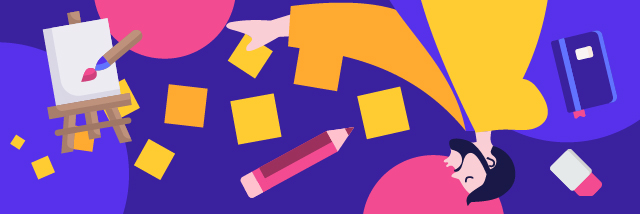Freelance, it seems that word is on everyone’s mouth these days. Around 57 million Americans are self-employed, and 38% of them identify as freelancers. I don’t know if you’ve heard, but it seems like remote work is also on the uptick. If anything, that trend looks like it’s going to be increasing. It seems the age of office drones is close to its conclusion. If you’re one of those gifted souls that has a gift for drawing, have you considered becoming a freelance illustrator?
Sure, I mean, something a little bit more career-oriented than being that kid who kept sketching in their notepad. But, if you’ve got a knack for illustrating, or have some professional experience, this may be the career choice for you. After all, times have changed, and there are plenty of jobs that can harness your passions, and make you a sustainable income.
Being a freelance illustrator also comes with a significant amount of perks over being an office worker. But yes, we’ll get to drawing in sandy beaches (don’t let water get to your Wacom!) and misty mountains in a bit. As much as freelancing can be a dream when it comes to mixing work and pleasure, it also requires work. Work, responsibility, time management, and plenty of hustle. Oh, yes, the hustle never ends.
But, if you’re one of those “get up and go” types, freelancing can be your golden ticket to a better life. It also doesn’t hurt that the freelance illustrator salary can be pretty juicy.
But, let’s not get ahead of ourselves. First things first!
If you prefer to watch a video instead, click here:
This post was updated on March 2021
What is a Freelance Illustrator?
Maybe you’ve never seen a sign on the street that says “freelance illustrator wanted.” But that’s because you were looking in the wrong place. Freelance illustrators are in very high demand, and I don’t foresee that will change in the near future.
A freelance illustrator, then, draws, or illustrates, for multiple clients. They’re self-directed, their own bosses and promoters, and tend to work on a per-job basis. But that’s just scratching the surface.
After all, graphic design and illustration careers have an almost endless subdivision of tasks. Let’s take a look at some of the most common.
1. Concept Art and Character Design
The toy, clothing, animation, clothing, video game, films, and other companies are always seeking out the creative talents of freelance illustrators. Since they’re known for their drawing flair, freelance illustrators are often tasked with coming up with outlandish, creative concepts. Of course, creativity is not always required; sometimes their clients will just require them to work within certain strictures.
2. Entertainment Art
This also covers a wide range of sub-sub-categories. Comics, matte paintings, storyboards, outsourced graphic novels, and other entertainment-related artwork. This may be work ancillary to what ends up on a particular production, like a video game or a movie, or it could be something that ends up on the screen. Many production companies outsource their material because they’re pressed for time, wish to cut costs, or simply don’t have enough talent on hand to meet all their deadlines.
3. Product Design for the Apparel and Textile Industries
Big textile companies usually have their own design teams. But, same as with the entertainment industry, sometimes they don’t have enough talent on hand, or they can’t make their deadline. Even under normal circumstances, they often hire a freelance illustrator or even create impromptu freelancer teams. Most of the work focuses on creating t-shirt patterns, or designs for other clothing and accessories. Plenty of big-name companies outsource frequently, like Disney, Mattel, etc.

4. Book and Editorial Illustration
There’s plenty of “freelance illustrator wanted” type situations in the publishing industry. We’re talking about blogs, newspapers, magazines, and websites. While there are a lot of stock illustrations going around, lots of renowned magazines turned to freelancers for art. There’s also plenty of work making book covers, or supplemental art material therein. This is a well that never runs dry.
5. Packaging Illustration
This profession is not packaging design — that’s the province of graphic illustrators. But, there’s plenty of product collateral artwork that calls for a freelance illustrator and their talents. The illustrations of this sort are then passed on to the graphic designer to incorporate into the final product. Packaging illustration covers all sorts of products, ranging from food items to toys (which, unlike your 3-year-old may have you believe, are not food).
There are many more jobs for which a client may hire a freelance illustrator. Some commission pieces directly from artists they like, for example. That’s why it’s important to have your freelance illustrator resume on point, but we’ll get to that below.
What is the Typical Freelance Illustrator Salary?
According to ZipRecruiter, the average annual pay for a freelance illustrator in the US is $59,000. They go on to say:
While ZipRecruiter is seeing annual salaries as high as $128,000 and as low as $18,000, the majority of Freelance Illustrator salaries currently range between $37,000 (25th percentile) to $70,000 (75th percentile) across the United States. The average pay range for a Freelance Illustrator varies modestly (up to $33,000), which suggests there may be fewer opportunities for advancement based on skill level, but increased pay based on location and years of experience is still possible.
All in all, it’s a pretty lucrative job considering you can mix work and pleasure, manage your time, and work remotely. If your score some consistent heavy-duty gigs, topping 100k a year is not outside the realm of possibility. But, as you can glean from this data, it’s a serious enough career path to merit serious consideration.
Do You Need a College Degree?
In short: no. While it can’t hurt to have extensive schooling and plenty of experience, that is by no means a barrier for entry. The freelance profession is a haven for the self-taught and self-reliant, but that doesn’t mean that formal education gets thrown by the wayside either.
While most clients won’t have a problem with you not having a degree, some will require you to have some level of certification. This may range from courses, proof of completion of previous jobs, to a degree in the case of the most stringent. While this is not something that’s going to plague you outright if you don’t have a formal education, it’ll come up from time to time. Some big companies tend to be stricter about requirements for hiring and some are more lenient. You’ll have to go on a case-by-case basis.
The great thing about being a freelance illustrator, though, is that more often than not you’ll find that prospective clients are just interested in your level of talent. That means that if you’ve got the artistic ability, they won’t care whether you back it up with certification. The freelance trade is extremely competitive by nature, and clients will ask you to put your money where your mouth is every time. Certifications may help you get in the door quicker in some cases, but no wall of diplomas can replace talent.
This doesn’t mean that you should slack off in any way, though. Artists need to consistently keep up with the latest techniques and developments, and always work on improving themselves. That’s why, even if you lack formal training, you’re required to constantly work on educating yourself. This is even more so for a freelance illustrator. Nothing will get you gigs faster than proving you’re a great artist.
Your Freelance Illustrator Resume
If you want to get jobs on a consistent basis, then you’ll need to display as much of your work online as possible. You need to provide easy, accessible ways to elegantly display your artwork and the jobs you’re most proud of. You won’t believe how many would-be clients are scouring DeviantArt for talented freelancers.
Another great resource is Behance. You’d do well to have your entire portfolio uploaded there, as it’s a convenient way for new clients to see if they like your work or not. Most freelancers have a link to their Behance on their profiles.
Having a well-organized portfolio is an integral part of being a freelance illustrator. Regardless of your chosen platform(s), they serve as your calling card. Few other professions are as centered on visual flair as being an illustrator.
As always, start with your best foot forward: display the art you’re the proudest of upfront. Try to wow them at first glance, and you’ll have made things considerably easier for yourself. If you’ve done work for well-known brands and companies, that’s another way to easily display your value as a hired.

“Freelance Illustrator Wanted,” Says the Internet
So, we’ve established how jobs can find you, but where can you find them, exactly? The internet is overflowing with job opportunities for freelancers, thankfully. The realm of the freelance illustrator is no different. You’re going to be spoiled for choice if you know where to look for.
Your best bet is to try freelancing platforms, like ours, of course.
At first, you’d understandably be in the lower end of the rate spectrum, but as you build your freelance illustrator resume, then you’ll easily start making more money as the months go by. Of course, the more job experience you have, the more you can skip rungs on the freelancing ladder. If you’re just starting an illustrator, don’t expect to get by on massive strokes of luck.
And, of course, you’ll have to hustle. A big part of being a freelancer is constantly applying for jobs. You’ll need to have your social game on point. In essence, being a freelancer requires you to be your own 24/7 PR machine. As you start to get more consistent work, that becomes less of an issue, but in the beginning, expect to spend a big chunk of your workday on client outreach.
The Bunny Studio Solution
There’s another way for you to get consistent work as a freelance illustrator and avoid the constant grind of trying to find clients.
If you’ve already established yourself as an awesome artist, you’ve got a real shot at landing a job with us at Bunny Studio. We hire creative, talented freelancers, and we set them up with great clients. We pride ourselves on treating both clients and freelancers right, fast turnarounds, quality, and providing a reliable satisfaction guarantee.
The main difference with other freelancing platforms is QA oversight. Instead of leaving you on your own, we mediate communication with the client to ensure that everything’s crystal clear every step of the way.
There’s a big focus on passing Bunny Studio quality standards. If you do, you’ll get paid even if the client doesn’t like your work for some reason. If it’s good enough for us, then you get your money.
Of course, you’re going to need to know your stuff to become a Bunny Pro. But, if you do (and don’t get discouraged if you have to apply a few times!), you’ll have an awesome team hooking you up with great clients and a constant stream of work. That already takes plenty of weight off your back, and you can just focus on what you love most.









